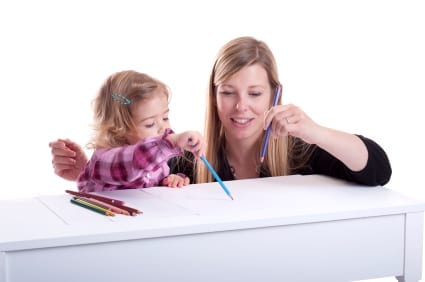 Sure, the umbilical cord was cut when your baby was born. Someone dramatically made that SNIP, severing the physical connection between you and your child. Perhaps it was epidural, perhaps the sheer exhaustion after giving birth, but that SNIP didn’t hurt a bit. So how come now, three years later, as you think about sending your child to her first year of preschool, the pain of that separation is so raw?
Sure, the umbilical cord was cut when your baby was born. Someone dramatically made that SNIP, severing the physical connection between you and your child. Perhaps it was epidural, perhaps the sheer exhaustion after giving birth, but that SNIP didn’t hurt a bit. So how come now, three years later, as you think about sending your child to her first year of preschool, the pain of that separation is so raw?
The transition to preschool is difficult for so many reasons, but most of all because we are entering the unknown. As parents, this is our first entry into the world of education and we feel, somewhat surprisingly, unprepared. How can I help my child get ready? What if he doesn’t make friends? Will the teacher understand what she is saying when she is crying? What if he has an accident? Is she ready to be away for so long? Yes, most preschool directors loving hold our hands through the process, offering open houses to allow us to get comfortable with their program, but sometimes it is helpful to get a handle on the bigger picture.
Preschool offers children an opportunity to practice the pre-academic skills that they will need in school. “Pre-academic” skills are those that they need before they can begin learning reading writing, mathematics, and all of the other “academic” tasks. Though each state regulates specific standards for preschools, pre-academic tasks typically fall into six basic categories: self-help skills (taking care of their own bodies), motor coordination (climbing, kicking, snapping), social-emotional growth (sharing, following rules), language development (understanding what others are saying and expressing themselves), cognitive development (thinking), and study skills (transitions, organization). Effective preschools create learning environments that will encourage students to play and effective preschool teachers guide children in their play in order to develop their skills.
So as a parent, what can you do to help your child through preschool? First of all, put away the flashcards and workbooks! Although they are not harmful in moderation, your child may not be ready for academic learning yet, and by pushing him to do workbook pages, you may be turning him off of school. Next, begin to understand how and why your child learns.
There are three things to keep in mind when thinking about how children learn: a) learning is best done through social construction, b) learning takes place through language, which children develop through repetition and modeling, and c) children learn best when adults provide structures and routines.
First, children learn best through social interaction-when they are able to construct their own knowledge through interacting with others. Although adults can certainly teach their children, learning is often even more effective when children are learning with peers-constructing the knowledge together. In preschool, as children play together in different centers, they are constructing knowledge. So, offer you child opportunities to play with other children. Not only will it give you a chance to be with other mothers, it is actually more beneficial to your child-how wonderful!
Second, learning takes place through language, which children develop through repetition and modeling. So now you set up opportunities for your child to play other children and you get to spend time with other parents. For you, part of this time might need to be catching up over a cup of coffee. However, your child also needs guidance. Time and again, children need adults to intervene in their play, proactively guiding them through social interaction. I’ll give you an example from my kids:
Jenna: “He took my shovel!”
While it is tempting to just make him give it back and turn back to my coffee, this is a golden moment-a time to model a social interaction. Here it goes….
Me: “Please give back the shovel and then use your words to ask for a turn.
Say, ‘Can I have a turn with the shovel?”
Jenna: “Can I have a turn with the shovel?”
Marco: “No”
Jenna: “He said ‘no’”
Me: “No is not okay. Can you say, ‘I’m using it right now, I’ll give it to
you in one minute.’”
Marco: “I’m using it right now, I’ll give it to you in twenty minutes.” (I have a
Smart-alec son)
Mom: “Twenty minutes is too long-you wouldn’t want to wait that long. Can
you give a more reasonable time?”
Marco: “I’m using it right now, I’ll give it to you in three minutes.”
We have been through this type of interaction umpteen times, but now, as I am cooking dinner in the kitchen, I can hear them using those exact words with one another as they work things out on their own. The power in this type of interaction is two-fold: first, they are learning how to use words and second, they have the control to determine when they give up the toy. Teaching kids that they can have control is an incredibly valuable lesson. Believe it or not, in that instance, you are preparing your child to have the power to get him or herself out of dangerous situations later in life. Yes, it is true.
Finally, children learn best when adults provide structures and routines. Our brains respond best when they are given a framework within which to work. Children need us to structure those frameworks for them for them, give them opportunities to practice skills within those frameworks, and, finally, once they are more comfortable, fashion the frameworks into their own way of knowing. Think about the way that musicians work on new pieces. They are given the basic framework of the piece (the key) and specific notes to play. They learn to play the notes of the song and it takes time for them to become comfortable playing those notes. Once they are comfortable, however, they begin to improvise, creating their own music.
Routines work because they are consistent and predictable. Whenever we first introduce a routine, there is often some resistance. However, as long as we consistently follow the routine, the resistance decreases. When I first started trying to brush my son’s teeth, he fought tooth and nail, but now that he expects his teeth brushed every morning and evening, he happily runs to the sink (okay, maybe not always happily, but he is usually running to make sure that he beats his sister.)
Effective preschools follow routines each day. Typically, this might include open play, circle time, craft time, snack, story time, and music. Whatever the activities, the children have a good idea of their order each day. Although it is not important (and is virtually impossible) to organize such firm routines at home, it is helpful to ensure that your child has a specific structure to his or her day. For some children, predictability is more important than for others, but all children appreciate having some understanding of what comes next.
Because, as I said earlier, language is so critical to developing thought, scripts are one important type of structure that you can use to help your child prepare for preschool. My daughter loves using scripts that we take from books. When she just turned two, she went through a period of, um, how can I put it nicely? Aggression? At the time, we happened to come across the perfect book for an “aggression” script: each page asked “What can you…(bite, kick, hit)?” and had a flap to lift for the answers (an apple, a ball, a drum). We used the book as a framework during processing each time she had an incident. The script gave her brain the language to teach her not to bite, hit, and kick.
So know that you have a better understanding of the world that your child is entering, will it be any easier to let go? For some, it will, for others, maybe not. However, just like my son, who resisted that tooth brushing, eventually dropping your child will become part of your routine.
About the author:
Donna Volpitta, Ed.D., is a parent of four and living in Pound Ridge, NY. A classroom teacher for over ten years, she draws upon her knowledge to conduct workshops for teachers and parents about numerous topics, including special education laws and social language instruction. Dr. Volpitta created the Pathways to Empower Program because “Just say ‘no,’ just doesn’t work.” The program helps give children the knowledge and confidence that they need in order to make smart decisions.
Dr. Volpitta is a on the board of One Revolution (www.one-revolution.com ) and she is an educational advisor for Little Noodles, an educational television production company. Additionally, she writes an education blog for www.modernmom.com. Dr. Volpitta has authored several articles, received a grant from the Department of Education, and has given presentations at numerous professional conferences.





